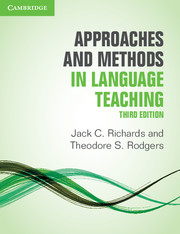Book contents
- Frontmatter
- Contents
- Acknowledgments
- Introduction to the third edition
- I Major trends in twentieth-century language teaching
- II Current approaches and methods
- III Alternative twentieth-century approaches and methods
- IV The teaching and learning environment
- Appendix: Comparison of approaches and methods
- Author index
- Subject index
19 - Learners, approaches, and methods
Published online by Cambridge University Press: 08 April 2022
- Frontmatter
- Contents
- Acknowledgments
- Introduction to the third edition
- I Major trends in twentieth-century language teaching
- II Current approaches and methods
- III Alternative twentieth-century approaches and methods
- IV The teaching and learning environment
- Appendix: Comparison of approaches and methods
- Author index
- Subject index
Summary
Introduction
Learners occupy a prominent role in the description of approaches and methods presented in this book. At one level, this is seen in the learning theory that supports the teaching strate-gies recommended in each method, since learning theories describe the processes learners are assumed to make use of in second language learning (Atkinson 2011). At another level, the roles assumed for learners in each approach or method, as described throughout this book, also account for the kind of learning expected of learners, the ways they are expected to interact with the teacher and other learners in the classroom, and the ways in which they use the learning arrangements and resources the method makes use of (see also Senior 2006). Learners are, of course, at the center of all theories of teaching, and their role in learning has been studied from many different perspectives, including those seen in the disciplines of psychology, education, and second language acquisition (Ortega 2009; Alsagoff 2012). A focus on learners and their contribution to learning appeared in many fields of education in the 1980s with the notion of learner-centeredness – an educational philosophy that has had a wide impact on education in the last 50 years in both general education and language teaching (Nunan 1988; Breen 2001; Blumberg 2004). This represents a broader view of the contribution of learners to learning – one that can be seen as either complementing the views implicit in different approaches and methods or prompting a rethinking of some of the assumption of methods. One of the assumptions underlying a learner-centered perspec-tive is that learning is not necessarily a mirror image of teaching. Learners bring dispositions to language learning that may operate in tandem with the assumptions of an approach or method, or independently of it, as we have seen with the theory of Multiple Intelligences (Chapter 12). Successful learners create their own learning pathways, and effective teachers seek to recognize learners’ approaches to learning, to help them acquire effective learning strategies and to build a focus on the learner into their lessons.
In this chapter we will examine the notions of learner autonomy, learner strategies, and learning styles and how these relate to our understanding of approaches and methods. We will then consider the role of technology in supporting the learner's role in language learning.
- Type
- Chapter
- Information
- Approaches and Methods in Language Teaching , pp. 331 - 345Publisher: Cambridge University PressPrint publication year: 2014



